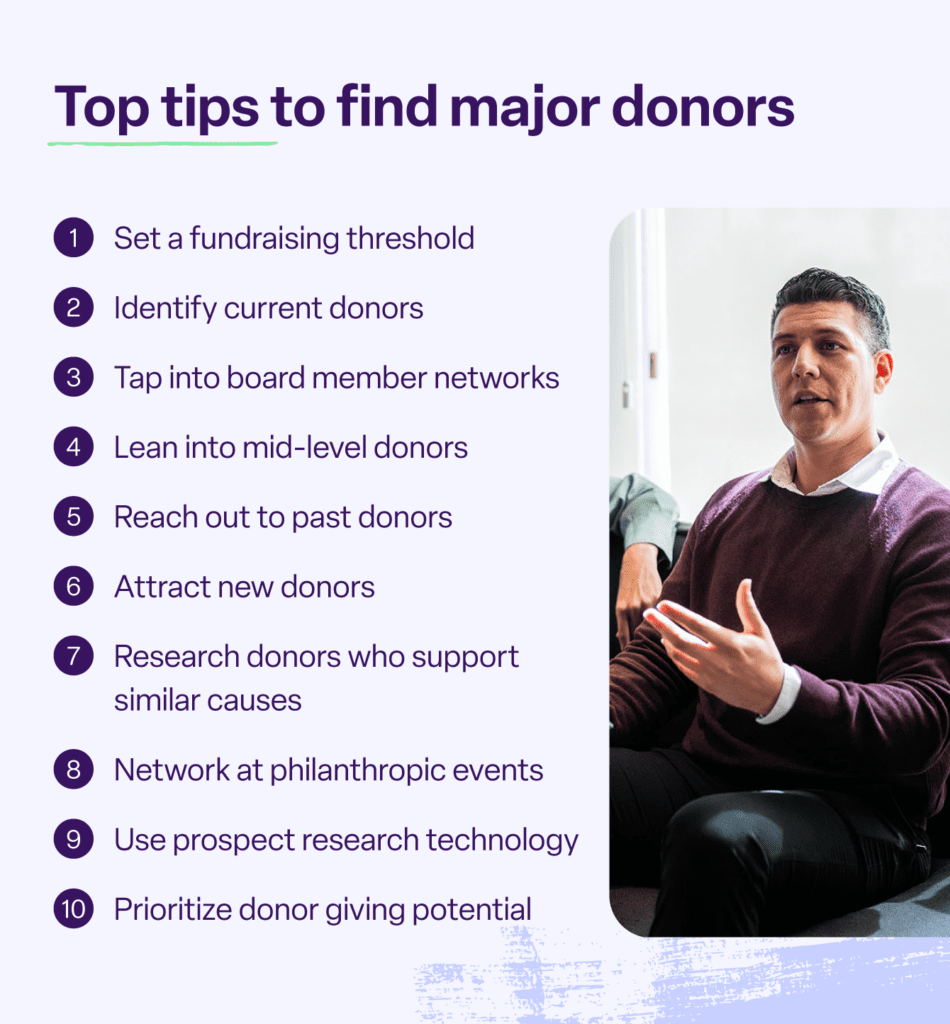Major donor fundraising: The ultimate fundraising strategy guide for securing large donations

For many nonprofit organizations — whether small and emerging or big and established — a handful of major donors play an instrumental role in your bottom line.
While these contributors might make up a small segment of a nonprofit’s donor cultivation strategy, their impact accounts for a large percentage of its annual revenue. In fact, as much as 90% of nonprofit fundraising revenue comes from major donors. But how exactly do you find and manage these large contributors?
Let’s walk through the process of attracting major donors and establishing a strategy to grow your fundraising program.
What are major donors?
Major donors are important because they allow nonprofits to significantly grow their impact by funding Major donors are those who contribute the largest financial gifts to an organization. However, there isn’t a specific amount that qualifies as “significant.” This amount is subjective to your organization’s donor portfolio.
For some, a contribution of $10,000 or more is considered significant. For others, $20,000 or even $30,000 is a more appropriate threshold.
If you don’t know who your major donors are or what qualifies as significant, there are some simple steps you can take to determine these criteria.
How to identify your major donors
If you’re in the early stages of major donor fundraising, you can start identifying your major donors by following these steps.

1. Set major donor fundraising threshold
Using the following process, leverage the data in your constituent relationship management system to set the minimum amount you define as a major gift:
- Step 1: Generate a list of all your donors and all the donations they made to your organization last year. As an example, let’s consider an organization with 100 donors in the past year.
- Step 2: Sort the list with the biggest gifts (and donor names) at the top. For instance, you’ll list that Sherlock Holmes donated $20,000, Harry Potter donated $10,000, Jane Eyre donated $8,000, and Elizabeth Bennet, and Clarissa Dalloway each donated $5,000 a piece.
- Step 3: Take the average of the top three to five largest gifts. In our example, the average would be $10,750.
2. Identify current major donors
When creating your list of major donors, start with those you have the best relationship with and work outward. Take the list of existing major donors created in the prior step and identify anyone else you’d like to include, such as:
- Small donors with larger gift potential
- Working or fundraising board members
- Donor leadership team members
- Lapsed donors
- Referrals and relevant contacts
Think of this list as a living document from which you regularly add and remove names. Over time, as your program gets off the ground and you acquire more major donors, you’ll be able to nuance your processes, adjust your thresholds, and better source and tailor your list.
3. Tap into board member networks
Your major donors are often involved in boards and foundations, connecting them to individuals with both the resources and desire to support your cause.
Tapping into these contacts can help identify additional major donor opportunities. Even if they can’t directly support your organization, they may be able to connect you with others who can.
Reach out to both current and former board members to build your contact list and form new donor relationships. both a high giving affinity and capacity will be your highest major donor prospects and the ones to focus your attention on.
4. Lean into mid-level donor giving power
Supporters don’t necessarily have to be wealthy to become a major donor. For example, you may find that many of your small, recurring donors have both the financial capacity for and interest in becoming large donors.
Often, a personal message or meeting can motivate these mid-level donors to become major contributors. At a minimum, opening up a line of communication can give you insights into the motivations and projects your smaller donors are interested in. You can then use this information to build on certain campaigns that drive large donations.
5. Reach out to past donors
Finding new prospects is much more time-consuming than tapping into your existing contact list, so you shouldn’t ignore past donors.
Similar to a mid-level donor strategy, one-time donors offer a huge opportunity for securing additional donations. Reach out to former donors and see if they’d be interested in donating again. They may even be open to increasing their contributions or giving consistently.
6. Hunt for new donor prospects
While donor acquisition is more time-consuming, it’s still an important part of a robust fundraising strategy. Looking for prospects outside your current database can bring in new opportunities for one-off and recurring gifts.
Prioritize networking at events and setting up meetings with new contacts to keep your pipeline fresh.
7. Search donors who support similar causes
If you’re just beginning to look for new prospects, try searching for donors who already contribute to similar or tangentially related causes. You can do this by checking the donor lists of related nonprofit organizations.
If they donate to similar causes, they’ll likely be open to extending their support to your mission.
8. Network at philanthropic events
Relationship building is a crucial part of fundraising, so it’s good to look for networking opportunities. You can host and attend fundraising events related to your cause to discover new contacts and develop potential donor relationships.
It’s also a good idea to prepare ahead of time by noting the attendees and making a point to engage with specific prospects during the event.
9. Use technology for prospecting
Fundraising has come far in recent years, and there are several prospect research tools to simplify your efforts. You can use social media to connect with a larger network, and some channels, such as LinkedIn, even offer prospecting features to keep your leads organized.
Beyond expanding your reach, data analytics tools can help you identify trends and report on engagement metrics, making donor discovery easier.
10. Determine donor giving potential
Finally, determine your organization’s most promising donors on your list based on a combination of wealth and philanthropic factors. We recommend using a scoring model that helps determine who on your list you should contact first, where each scoring category equals one point.
Consider the following elements in your scoring model:
- Relationship to your nonprofit: Often, major donor prospects already have a connection to your organization. Consider board members, staff, and volunteers who might be good prospects for major gifts. Score a point for each activity they’ve participated in during the past three years.
- Giving summary: Gift frequency can indicate a willingness or capability to become a major donor. Award a point for each consecutive year a person’s made a gift.
- Birthdate: Age may indicate a person’s available assets. Prospects with school-aged or college-aged children may not have disposable income or assets to donate. On the other hand, retirees may be in a better position to give. You might, for example, assign a point to prospects over 50.
- Employer: Is there potential for a corporate gift as well as a personal one? If yes, add a point.
- Professional title: Is your prospect an owner, principal, or decision-maker at a large company? If yes, score a point.
- Giving history: Have they made previous major gifts to your organization or another nonprofit? Score a point for each gift made.
Note the total amount of points assigned to each donor prospect. For example, if a prospect earns one point for each category, their score is 6. Individuals with both a high giving affinity and capacity will be your highest major donor prospects and the ones to focus your attention on.
How to steward major donors
Now that you’ve identified your major donors, the next step is deciding how to cultivate major donor connections. Stewarding donors is all about building meaningful relationships with prospects to increase gifts. Follow these steps once you’ve identified prospects you’d like to move forward with.
1. Meet with major donor fundraising prospects
In-person meetings are the single most important step you can take to acquire a major donor because they show prospects that your organization values their contributions.
Put your best foot forward in preparing for a major donor meeting with these steps:
- Secure the appointment: Plan for 30 minutes of making phone calls to secure one appointment. That includes leaving voicemails, speaking with gatekeepers, and scheduling the meeting.
- Choose a quiet meeting place: Meeting at their office demonstrates respect for their time while meeting at your headquarters can give them a better understanding of how you deliver on your purpose.
- Prepare for the meeting: Set aside up to 30 minutes prior to the visit to conduct research, prepare pertinent materials, and plan for the visit.
- Ensure enough time for a productive meeting: Budget two hours for each visit, and don’t forget to leave yourself time to travel to each appointment. It’s better to have extra time between appointments than to rush the end of a valuable conversation.
- Conduct follow-up: Plan for up to an hour post-visit for follow-up correspondence, internal coordination, and planning next steps.
Approximately 10% of your working hours should be committed to major donor acquisition. On average, you should budget four hours per major gift appointment. If you’re just starting out, try doubling that to 20% and schedule at least two face-to-face visits each week.
2. Ask open-ended questions
Once you have a donor’s attention, what should you say? While you might feel obliged to share every While you might feel obliged to share every detail of your nonprofit’s work, it may be more productive to give your attention to the prospect and give them space to talk.
Instead of lecturing them about your nonprofit’s work, probe their philanthropic passions and habits via a series of open-ended donor survey questions, such as:
- What made you give to our organization in the first place, and what motivates you to keep giving?
- What do you like most about our organization? What are some things you would change?
- What do you think we should be doing more of or better?
- What advice would you give our organization?
- What other organizations do you volunteer for or give to and why?
- Would you consider volunteering for us in the X or Y program?
Use what you learn to continue the conversation in future meetings and emails. Stewarding a donor can take months, so be ready to have long, detailed conversations about these topics. After each conversation, record their responses in your database to refer back to in the future.
3. Do your research and keep it organized
Conducting prospect research allows you to tailor your engagement and outreach to each donor. The more information you have on a donor and their motivations, the better your conversations will go.
Beyond their name, address, phone number, and email, consider storing the following information on major donors in your management system:
- Birthdate: As noted above, age can be a good indicator of giving capacity. A donor’s birthday also provides a great outreach opportunity for your donors.
- Spouse name: Knowing a spouse’s name can make your life easier when you’re addressing event invitations. You should also consider attaching children’s names to donor records.
- Employer: Does this donor’s employer offer matching gifts? What about corporate sponsorships?
- Key roles in your organization: Has this donor also served as a volunteer, board member, event host, or fundraising ambassador?
- Social media profile links: A donor who is very active online and feels comfortable sharing on Twitter, Facebook, and LinkedIn can help you with your next peer-to-peer campaign.
- Communications record: Track all communications sent to and received from each donor.
- Meeting notes: After each conversation, record a summary in the person’s record.
- Action steps: Assign tasks and reminders to follow up with major donors on outstanding items. For example, even if you haven’t set a time for a follow-up conversation with the donor, set a task to remind yourself to reach out so that the next steps can be determined.
To keep this information as accurate, accessible, and safe as possible, use a donor management system. The right system will allow your team to access a prospect or donor’s information and track patterns in your major giving program with the click of a button.
4. Share your appreciation regularly
Major donors are more likely to continue giving when they feel like they’re an integral part of your organization. Here are some major gift fundraising best practices to show your appreciation and inspire continued support:
- Encourage group meetings: Invite major donors and prospects to the home or club of a peer leader for a chance to mingle and network with like-minded advocates.
- Celebrate important milestones: Reach out on the anniversary of their first major gift to show them how much they matter to your organization.
- Host special events: Put together fundraising events that cater specifically to your major donors. Invite them to galas, auctions, happy hours, or book clubs, where you can engage them in conversations that may lead to more donations.
Remember that donor recognition involves more than just saying “thank you.” It’s about treating your major donor as a partner throughout the entire giving process, from acknowledging the impact of their gift to using it as they intended.
As you extend your gratitude, relay the impact of their contributions. For instance, did their gift help you build a new facility, extend your services to a new community, or exceed a fundraising goal?
5. Use technology to highlight impact
Highlighting how donor contributions directly influence your organization’s mission is a powerful way to show impact and appreciation. However, manually pulling together past data and future projections can be extremely difficult. That’s where the use of fundraising software and digital education can help, including:
- Impact reports
- Newsletters
- Webinars
- Workshops
These tools can all help you provide donors with updates on the influence of their donations. This can push one-time donors to contribute monthly and small-level contributions to up-level their gifts.
6. Hold stewardship activities
Hosting activities and events specifically for major donors can help them feel involved and in the loop on the impact of their contributions. Consider getting your donors involved in activities like:
- Stewardship visits: This is an opportunity to give donors an in-depth look inside your organization, the people who run it, and any new projects you’re launching to support your mission.
- Personalized gift opportunities: A yearly gift of appreciation around the holidays or special milestones can show donors how much their support means to your organization.
- Legacy planning: Involving donors in the financial planning process can help them feel a part of your mission and goals. Even just being able to attend the meeting without contributing is a nice way to acknowledge their support.
- Volunteer opportunities: Financial contributions aren’t the only way to support your organization’s mission. Let donors know about upcoming volunteer opportunities so they can provide additional support where needed.
Why is major donor fundraising important?
Major donors are important because they allow nonprofits to significantly grow their impact by funding their programs and operations. More specifically, they carry three main benefits:
- Gives your team “breathing room”: It can take a lot of small gifts (and a lot of effort soliciting those small gifts) to reach your fundraising goals. For example, it would take 800 donations of $25 a piece to match a single $20,000 gift. Major donors give you time to consider your big-picture fundraising strategy and ultimately make your small gift fundraising more effective.
- Sets a precedent for giving: Research from the University of Wisconsin shows that major gifts “signal to all other givers that the charity is of high quality.” When major donors make a donation, smaller donors, in turn, become more likely to offer you their support as well.
- Contributes larger donations: According to the IRS, households with an annual income of $2 million or more account for nearly one-third of the money donated to nonprofits each year.
Launch your major donor fundraising strategy.
By implementing a robust major donor fundraising strategy, you can unlock significant financial resources to fuel your mission. While securing major donors takes time and commitment, the right fundraising solution can help streamline the process.
From multi-channel management to predictive analytics, Bonterra’s fundraising software solutions can help you launch and grow your major giving program. Ready to elevate your fundraising efforts? Request a demo to get started.
FAQ
Who is considered a major donor?
A major donor is a supporter that provides the largest contributions to a nonprofit organization. The threshold for a major gift is relative to your organization’s specific donor base and fundraising goals.
What are the three types of donors?
The three main types of donors are individuals, corporations, and foundations. Individual donors tend to be the most common small to mid-level gift supporters, while organizations and foundations are more likely to provide major donor gifts.
How do you find major donors?
To find major donors, follow these 10 steps:
- Set a major donor fundraising threshold
- Identify current major donors
- Tap into board member networks
- Lean into mid-level donor giving power
- Reach out to past donors
- Hunt for new donor prospects
- Search donors who support similar causes
- Network at philanthropic events
- Use technology for prospecting
- Determine donor giving potential
Work with Bonterra



